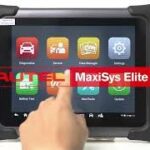Vcds Hex+can Software is a powerful diagnostics tool for Volkswagen, Audi, Seat, and Skoda (VAG) vehicles. This comprehensive guide provides essential information about the software, its features, and how to use it effectively for troubleshooting and maintenance. Although the HEX+CAN interface is a legacy device, this software still functions with it for older vehicles.
Understanding VCDS HEX+CAN Software
VCDS software, developed by Ross-Tech, allows users to access and interact with the various electronic control units (ECUs) within a VAG vehicle. It provides detailed information about the vehicle’s systems, including fault codes, live data, and coding options. While newer interfaces like HEX-V2 are recommended for modern cars, VCDS software running on a HEX+CAN interface is still relevant for owners of older VAG models.
Key Features of VCDS
- Comprehensive Diagnostics: Read and clear fault codes from all vehicle systems, providing detailed descriptions and possible solutions.
- Live Data Monitoring: Observe real-time sensor data, allowing for precise diagnosis of intermittent issues and performance monitoring.
- Coding and Adaptations: Customize vehicle settings to personal preferences or activate specific features. Examples include enabling/disabling daytime running lights, adjusting comfort features, and modifying convenience settings.
- Output Tests: Activate individual components like actuators and relays to pinpoint faulty parts. This feature helps isolate problems without guesswork.
- Basic Settings: Perform various system resets and calibrations, ensuring optimal performance after repairs or maintenance.
Compatibility of HEX+CAN
Important Note: Ross-Tech’s HEX+CAN interface, while supported by this software, will not work with model year 2019 and newer VAG vehicles. Those require a current-generation interface such as the HEX-V2. The HEX+CAN is considered a legacy interface and is best suited for older models. Consult Ross-Tech’s compatibility charts to confirm compatibility with your specific vehicle.
Getting Started with VCDS HEX+CAN Software
- Software Installation: Download the latest VCDS software from the official Ross-Tech website. Follow the on-screen prompts for installation. The software must be installed on your computer’s hard drive, not run directly from removable media.
- Interface Connection: Connect the HEX+CAN interface to your computer’s USB port and the vehicle’s OBD-II port. Ensure the vehicle’s ignition is switched ON (engine not necessarily running).
- Software Setup: Launch the VCDS software. Select the correct communication port under [Options] and test the connection using the [Test] button. Save these settings.
- Begin Diagnostics: Select the desired control module from the main screen. From there you can read fault codes, view live data, perform output tests, access coding functions, and more. Refer to the comprehensive VCDS manual for detailed instructions on each function.
Keeping Your VCDS Software Updated
Regularly check for software updates on the Ross-Tech website. Updates often include new features, bug fixes, and expanded vehicle coverage. Keeping your software current ensures optimal performance and compatibility. Although the HEX+CAN will not work with newer cars, software updates are still important for bug fixes and maintaining functionality with vehicles it does support.
Conclusion
VCDS HEX+CAN software remains a valuable tool for owners of older VAG vehicles. It empowers users to perform advanced diagnostics and maintenance tasks, potentially saving time and money. Remember to confirm compatibility with your vehicle before purchasing or using the software and interface. For newer vehicles (2019 and later) a more modern interface is required. Consult the Ross-Tech website for the latest information and compatibility charts.
[

